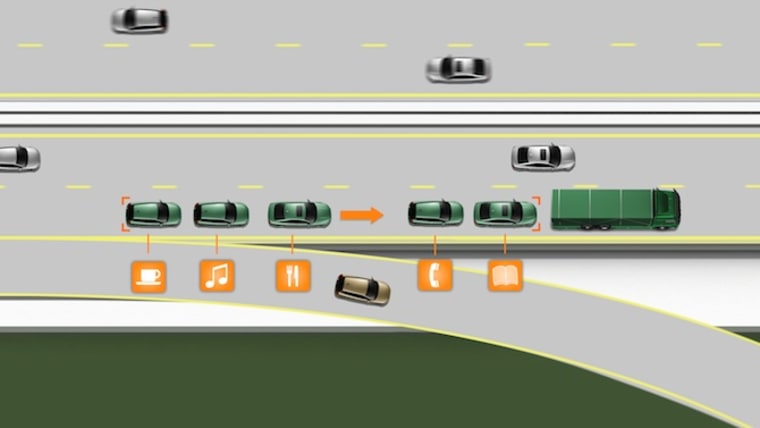Google may be grabbing headlines for its experiments with driverless cars, but fully robotic vehicles probably aren't the next step in our automotive future — think about how long it will take for governments to approve the technology and for auto companies to manufacture driverless cars en masse. Instead, we may soon see vehicle platoons (aka "road trains") that allow software-equipped cars to automatically follow a professional driver in a "lead car." It's a technology that could reduce congestion and increase both speed and fuel economy — and according to Volvo, it may be on European roads by 2020.
"This is easier than what Google is trying to do," Erik Coelingh, a technical specialist at Volvo, tells Fast Company. "What we are trying to do is take a step in the middle between the adaptive cruise control cars that we have today and the Google car that we have in the future."
When road train technology is commercialized, a driver equipped with platooning software could use an in-vehicle navigation screen to find the nearest platoon and drive to the end of it. At that point, the car could wirelessly connect to the platoon and take over braking, acceleration, and steering —and drivers could safety start texting or watching a movie.
Volvo imagines that professional drivers would lead each platoon, though there is no technical reason why regular drivers couldn't take over. But just as bus drivers are required to have special licenses, Coelingh believes that road train lead drivers should probably have special qualifications for the job. Employing professional drivers would also remove a lot of legal hurdles, since each road train would be led by a real, live human.
Beyond giving drivers the opportunity to relax on the highway, road trains have a number of advantages over today's cars: They're ostensibly safer, and they save fuel (driving close to the car in front of you reduces aerodynamic drag forces, which are a major contributor to fuel consumption).
So far, Volvo has successfully completed tests on a closed track in Sweden with one lead vehicle and one following car. Next up: driving in platoon formation with several vehicles at the same time on a closed track, and then moving into the real world.
Volvo is working on road platooning as part of the EU's Safe Road Trains for the Environment (SARTRE) Project, an (apparently existential) initiative that aims to put road trains on unmodified highways — no embedded magnets under the road, for example — where they can safely interact with traffic.
"What we want to try to do is take cars that we have in production today and modify them as little as possible in order to allow them to drive on the road-train platoon project," says Coelingh.
Major auto companies are already working on a common communication standard for intelligent vehicles. This will allow platoon-ready cars from a variety of automakers to communicate with each other.
There are still kinks to work out, of course. What happens if the software malfunctions while a car is in a platoon? How many auto companies need to be involved to make this viable on a large scale? And who will pay the professional drivers?
"We're in the research stage, so we cannot solve all the problems," says Coelingh. "The most important thing is that we have the cars communicating with each other."
Reach Ariel Schwartz via Twitter or email.
More stories from Fast Company:
